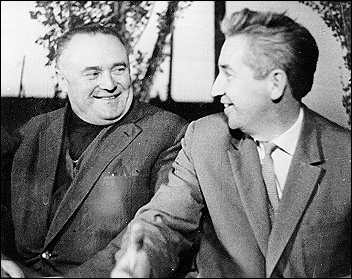Excerpts from "Der rote Orbit"
Sven Grahn, Sollentuna, Sweden
I have dusted off my old high
school German and perused the book "Der rote Orbit" (Red Orbit) by Harro
Zimmer, the former head of the Wilhelm-Foerster Observatory in Berlin and
later a science broadcaster for RIAS-Berlin (Radio In American Sector)
and Deutsche Welle. His book (published by the Franckh-Kosmos publishing
company in Stuttgart, ISBN 3-440-07226-6) deals with Soviet space history
and is based on personal inteviews with Sergei Afanasyev,ex-minister of
Machine Building and his deputy Vladimir Alaverdov, Boris Chertok, Konstantin
Feoktistov, Oleg Gazenko (professor of space medicine) G. Losino-Losinski
(Buran project) and cosmonauts Kuklin and Manarov.
Dates and Facts
I have just jotted down some
dates and facts given in Zimmer's book. I am sure these are not original
data but derived from other sources. Anyway, I list them all the same (and
please forgive the uncertain transcription of Russian names):
-
Isayev, Chertok and Mishin were
part of a study group to examine V-2 debris from firings in Poland. They
arrived in Germany on May 8, 1945 dressed in Air Force major uniforms with
Korolev, Georgi Tyulin and Maj.-Gen L. Gaidukov. The task was to lay hands
on missile technology and staff. Red Army Lt.Col Shabinski discovered part
of a cement factory in the Dora camp where missile components were manufactured.
With this and other equipment a V-2 assembly line could be set up, but
all the gear was sent to "NKVD-section Volga-Don".
-
Korolev named chief designer
for long-range ballistic missiles on 9 Aug 1946 by a decree issued by Defense
Minister Ustinov. Mishin was his deputy. In the weeks following this decree
52 engineers were gathered at Podlipki, i.a. B. Chertok, D.Kozlov, V. Kovtunenko,
V. Makayev, M. Reshetnyev, M. Tikhonravov, B. Rauschenbach.
-
20 May 1954: OKB-1 ordered to
proceed with R-7.
-
July 1954: Project documentation
for 8K71 in 15 volumes ready.
-
26 May 1954: Korolev writes
to the Council of Ministers to propose satellite.
-
30 August 1955: Akademi Nauk
discusses the satellite project. [This is the famous meeting. SG]
-
30 January 1956: The government
approves Object D satellite project. [This became Sputnik 3].
-
End of 1956: Obvious that Object
D would not be ready the following summer. Tikhonravov proposes simple
test satellite. Work on this started in early 1957.
-
The re-entry vehicle of the
21 August 1957 R-7 flight test disintegrated at 10 km altitude. It weighed
5400 kg.
-
There was a radar transponder
in the last stage of the R-7 that launched Sputnik 1. This transponder
was tracked after one orbit around the Earth to determine the orbit accurately.
Vostok and Zenit
 The
following summary from Zimmer's describes the development of Vostok and
Zenit and the text seems to be a summary of an interview with Feoktistov:
The
following summary from Zimmer's describes the development of Vostok and
Zenit and the text seems to be a summary of an interview with Feoktistov:
"........ In the beginning
of 1958 a working group within OKB-1 under Nikolai P Beloussov was working
on a project of manned flight in a ballistic trajectory. Feoktistov and
a few other colleagues worked out some preliminary ideas for a manned orbital
spacecraft and showed these to Korolev, using the fact that one of his
deputies, Bushuyev, was on holiday. Bushuyev favoured the intermediate
step in a ballistic trajectory, so it was important to by-pass him. the
choice of a spherical re-entry vehicle saved a lot of time, otherwise needed
to test the aerodymanical properties of a more complicated design. At this
time Feoktistov also proposed the use of an ejection seat for the cosmonaut.
Korolev gave Feoktistov the
task to prepare a more detailed paper on his ideas for a manned orbital
spacecraft. This paper was circulated within OKB-1 in August 1958. The
"Big Six" (Council of Chief Designers: Korolev, Barmin, Glushko, Kuznetsov,
Pilyugin, Ryasanski) met in November 1958 to discuss i.a. manned spaceflight.
There were presentations on three projects:
-
The reconnaisance satellite
presented by Yegenij F. Rjasanov,
-
The manned suborbital project
by Beloussov and finally
-
Feoktistovs proposal for a manned
orbital satellite.
Of course national priorities
would favour the reconnaisance satellite, but Feoktistovs group had worked
out a plan by which the manned spacecraft could be easily converted into
a reconnaisance satellite by ripping out all the unnecesary equipment for
manned spaceflight.
Korolev wanted a manned spacecraft,
but was not immediately prepared to drum up support. A compromise was reached
during this meeting in which the spacecraft would be designed to satisfy
both the reconnaisance and the piloted spaceflight requirements. The reconnaisance
satellite project naturally got top priority and the manned project naturally
benefited from this. [Imagine if Corona and Mercury had been the same project
in The US? Sven Grahn's comment]...."

 Back
to Space History Notes
Back
to Space History Notes
![]()
 The
following summary from Zimmer's describes the development of Vostok and
Zenit and the text seems to be a summary of an interview with Feoktistov:
The
following summary from Zimmer's describes the development of Vostok and
Zenit and the text seems to be a summary of an interview with Feoktistov:
![]()